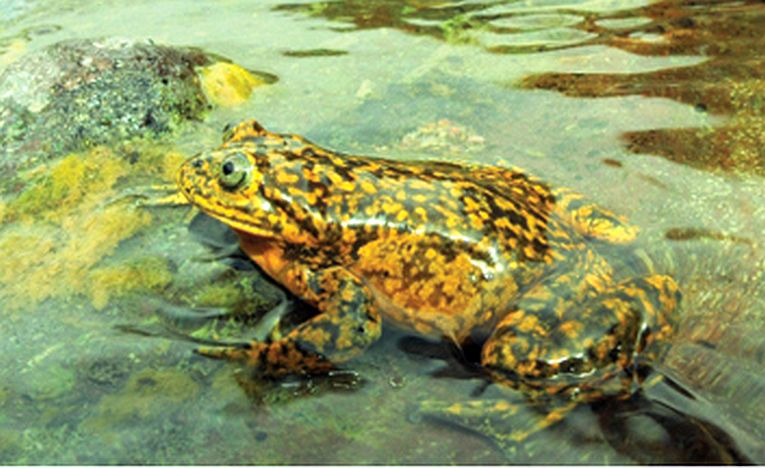At 3900m, in the central Andes, a new species of Peruvian frog was discovered in 2012 during a survey of the upper Pisco valley. This is not the ideal time for frogs,with chytridiomycosis rife and the presence of the fungus responsible in this location. The unusual discovery means the species must be rare, as it should have been recorded before, even in its tightly-restricted and arid coastal valley. Telmatobius ventriflavum has 2 close relatives that have been described but have few known specimens to compare. The tadpoles would be useful, but again, few of all the species have been seen! The adult is spectacularly bright yellow and dark brown, with red spots, and an orange coloration beneath, making it easy to identify.
The problems besetting herpetologists in the Andes are becoming obvious. In Chile, research has established that these western valley species are endemic to the Altiplano region. In comparison, 3 Ecuadorian Telmatobius species are already extinct because of the fungal attacks and other Bolivian, Argentinian and Peruvian members of this genus seem very susceptible to chytridiomycosis. Batrachochytrium dendrobatidis was present in over 50% of tadpoles and 40% of adults in the Pisco streams sampled for the new species. There are 62 species from this genus throughout the tropical Andes. The future population of Telmatobius ventriflavum, as well as its 2 closest neighbours, has to be monitored carefully. The urban projects, the coastal highway and more planned reservoirs and pipelines nearby will present even more hazards for frogs to overcome.
The slender body and length of body (up to 5.6cm) and legs makes the new guy very easy to use as a conservation icon. Few animals survive in these valleys with the higher elevations described as a sparse puna habitat. Pebbly and gravel pools supply the breeding habitat, with regular waterfalls and riffles. A dam already places a reservoir 500m downstream, so the frog’s habitat is very restricted with a few possibilities upstream to a height of 4300m. 43 tadpoles were found in the studied area, indicating successful reproduction, even in the dry season. The low levels of chytridiomycosis infection may show an element of hope that these individuals can survive. Read more in the Open Access and well-illustrated paper inZooKeys, written by Alessandro Catenazzi, Victor Vargas and Edgar Lehr of Asociacion Pro Fauna Silvestre, in Peru and Southern Illinois University Carbondale and Illinois Wesleyan University, US.
For information on amphibian (and mammalian) conservation problems in South America and elsewhere, we liked the very convenient Maps of the rare and unusual that appeared in Plos One 2 years ago.










